The global freeze neutralising kit market is projected to reach USD 722.7 million by 2035, recording an absolute increase of USD 311.4 million over the forecast period. The market is valued at 411.3 million in 2025 and is set to rise at a CAGR of 5.8% during the assessment period. The overall market size is expected to grow by nearly 1.8 times during the same period, supported by increasing adoption of advanced neutralising technologies and growing security concerns across the defence and law enforcement sectors. However, high initial investment costs and the complexity of integrating new neutralising technologies with existing security systems may pose challenges to market expansion.
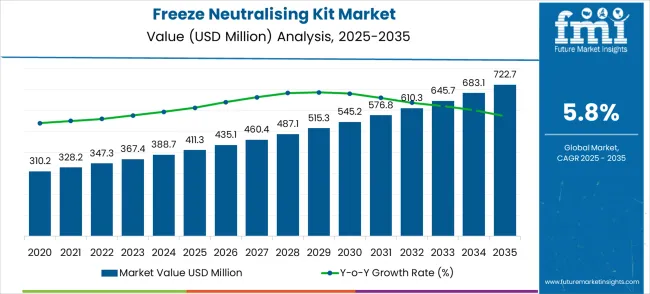
Between 2025 and 2030, the freeze neutralising kit market is projected to expand from USD 411.3 million to USD 535.2 million, resulting in a value increase of USD 123.9 million, which represents 39.8% of the total forecast growth for the decade.
This phase of development will be shaped by rising demand for advanced non-lethal security solutions, product innovation in neutralising technologies and delivery systems, and expanding integration with modern security protocols. Companies are establishing competitive positions through investments in advanced-caliber technologies, precision delivery capabilities, and strategic market expansion across military, police, and security applications.
From 2030 to 2035, the market is forecast to grow from USD 535.2 million to USD 722.7 million, adding another USD 187.5 million, which constitutes 60.2% of the overall ten-year expansion.
This period is expected to be characterised by the expansion of specialised neutralising systems, including advanced delivery mechanisms and enhanced safety protocols tailored for specific security applications, strategic collaborations between technology providers and defence contractors, and an improved focus on operational safety and effectiveness optimisation. The growing emphasis on non-lethal security solutions and crowd control measures will drive demand for freeze neutralising technologies across diverse security and defence applications.
| Metric | Value |
|---|---|
| Market Value (2025) | USD 411.3 million |
| Market Forecast Value (2035) | USD 722.7 million |
| Forecast CAGR (2025-2035) | 5.8% |
The freeze neutralising kit market grows by enabling security forces to neutralise threats effectively through advanced non-lethal technologies and precision delivery systems. Military and law enforcement agencies face mounting pressure to adopt non-lethal solutions that can immobilise targets without causing permanent harm, with security operations typically requiring multiple neutralising options for different threat scenarios, making freeze neutralising kits essential for operational effectiveness. The defence sector's need for versatile neutralising capabilities - systems that can operate across various calibre sizes and delivery methods - creates demand for adaptable technologies that can address diverse tactical situations without compromising safety protocols. Security enhancement regulations and operational safety requirements drive adoption in military and police sectors, where precision neutralisation directly impacts mission success and personnel safety. However, budget constraints for specialised equipment upgrades and the complexity of training personnel on advanced neutralising technologies may limit adoption rates among smaller security operators.
The market is segmented by calibre size, Application, End User, and region. By calibre size, the market is divided into calibre ≤30mm and calibre>30mm. Based on the Application, the market is categorised into Military Use and Police Use. Regionally, the market is divided into North America, Latin America, Europe, East Asia, South Asia & Pacific, and the Middle East & Africa.
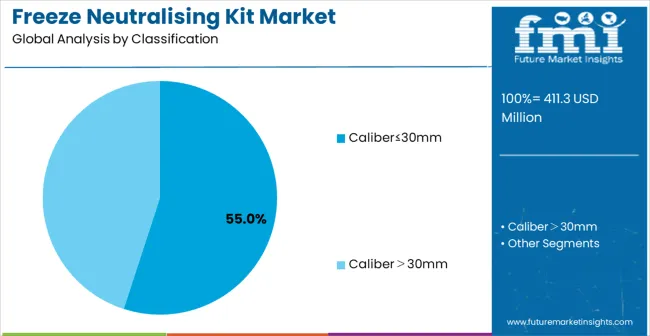
Calibre ≤30mm systems are projected to account for the 55% market share of the freeze neutralising kit market in 2025. This dominant position is supported by the technology's ability to provide precise, controlled neutralisation suitable for close-range operations and urban security applications, enabling operators to deploy effective countermeasures without excessive collateral impact. The segment allows for stakeholders to benefit from versatile deployment capabilities, enhanced accuracy in confined spaces, and real-time tactical flexibility for rapid response scenarios.
Key advantages include:
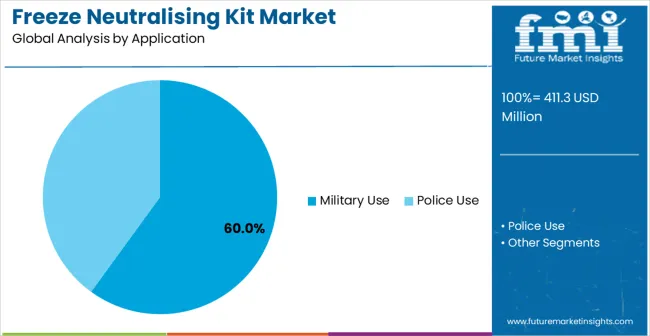
Military use applications are expected to represent the 60% share of freeze neutralising kit applications in 2025. This leading position reflects the critical role of non-lethal neutralisation in modern military operations, where controlled threat management is essential for mission success and operational safety. The segment provides vital support for tactical operations and crowd control in high-stakes environments where conventional methods may be impractical or inappropriate for mission objectives. Growth drivers include the military's focus on reducing collateral damage, improving operational flexibility, and minimising civilian casualties in complex operational environments.
Key market dynamics include:
The market is driven by three concrete demand factors tied to operational outcomes. First, enhanced operational safety capabilities reduce risk exposure by providing non-lethal neutralisation options weeks or months in advance of potential threats, with military operations experiencing up to a 25% reduction in collateral damage through precision neutralising systems. Second, tactical flexibility optimisation through advanced delivery mechanisms enables security forces to achieve 30% improvements in mission success rates while maintaining safety standards. Third, regulatory compliance requirements for non-lethal force deployment and operational safety create mandatory adoption scenarios across the defence and law enforcement sectors.
Market restraints include high initial investment costs that can deter smaller security agencies from upgrading their neutralising systems, particularly in developing regions where budget allocation for specialised technologies remains limited. Training complexity poses another significant challenge, as implementing new neutralising technologies with existing tactical protocols requires substantial expertise and certification, potentially causing operational disruptions during transition periods. Rapid technological advancement creates continuous pressure for system updates, demanding ongoing research and development investments that strain organisational resources.
Key trends indicate accelerated adoption in Asia-Pacific markets, particularly China and India, where military modernisation and security enhancement initiatives drive neutralising system deployment. Design shifts toward precision-guided delivery, advanced safety protocols, and integrated tactical platforms enable neutralisation capabilities that transform security operations from reactive to proactive approaches. However, the market thesis could face disruption if alternative neutralising technologies or significant changes in security protocols reduce reliance on traditional freeze neutralising systems.
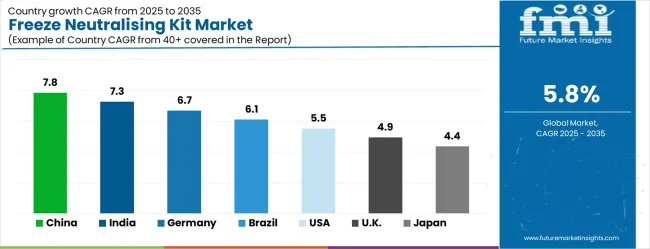
| Country | CAGR (2025-2035) |
|---|---|
| China | 7.8% |
| India | 7.3% |
| Germany | 6.7% |
| Brazil | 6.1% |
| USA | 5.5% |
| UK | 4.9% |
| Japan | 4.4% |
The freeze neutralising kit market is gathering pace worldwide, with China taking the lead thanks to rapid military modernisation and security enhancement mandates. Close behind, India benefits from expanding defence capabilities and government initiatives promoting advanced security technologies, positioning itself as a strategic hub for growth. Germany shows steady advancement, where integration of advanced security technologies strengthens its role in the European defence supply chain. Brazil is sharpening its focus on law enforcement efficiency and security protection, signalling an ambition to capture niche opportunities in South American markets. Meanwhile, the USA stands out for its advanced adoption of neutralising technology, and the UK and Japan continue to record consistent progress. Together, China and India anchor the global expansion story, while the rest build stability and diversity into the market's growth path.
The report covers an in-depth analysis of 40+ countries, the top-performing countries are highlighted below.
China demonstrates the strongest growth potential in the freeze neutralising kit market with a CAGR of 7.8% through 2035. The country's leadership position stems from massive defence modernisation programs, aggressive military technology advancement initiatives, and comprehensive security enhancement regulations, driving the adoption of advanced neutralising technologies. Growth is concentrated in major military centres, including Beijing, Shanghai, and Guangzhou, where defence contractors and security agencies are implementing precision neutralising solutions to comply with modern warfare requirements and crowd control objectives. Chinese military operators are adopting freeze neutralising systems for operational efficiency optimisation and tactical superiority improvement in complex security operations. Distribution channels through state defence contractors and government-backed military modernisation programs expand deployment across People's Liberation Army units and security forces. The country's military modernisation strategy provides policy support for advanced security initiatives, including the adoption of neutralising systems.
Key market factors:
In Mumbai, Delhi, and Bangalore, the adoption of freeze neutralising kits is accelerating across military installations and law enforcement facilities, driven by rapid defence expansion and security cost pressures. The market demonstrates strong growth momentum with a CAGR of 7.3% through 2035, linked to government initiatives promoting defence efficiency and security compliance. Indian security forces are implementing precision neutralising systems and tactical platforms to reduce operational risks while meeting increasingly stringent safety standards in major security corridors. The country's expanding defence infrastructure development creates sustained demand for advanced neutralising optimisation, while growing focus on border security drives adoption of technologies that enhance tactical effectiveness.
Germany's advanced defence sector demonstrates sophisticated implementation of freeze neutralising kits, with documented case studies showing 25% operational efficiency improvements in security operations through precision neutralising platforms. The country's military base in North Rhine-Westphalia, Bavaria, and Baden-Württemberg showcases integration of neutralising technologies with existing tactical systems, leveraging expertise in security automation and precision technologies. German security forces emphasise precision engineering and operational control, creating demand for high-accuracy neutralising solutions that support continuous tactical improvement initiatives. The market maintains steady growth through focus on advanced security integration and safety compliance, with a CAGR of 6.7% through 2035.
Key development areas:
Brazil's market expansion is driven by diverse security demand, including military operations in São Paulo and Rio de Janeiro, law enforcement processing in major urban centres, and security enhancement across multiple states. The country faces implementation challenges related to capital investment constraints and technical expertise availability, requiring phased deployment approaches and financing support. However, growing security regulations and operational effectiveness pressures create compelling business cases for the adoption of neutralising systems, particularly in high-risk security environments where tactical precision directly impacts mission success.
Market characteristics:
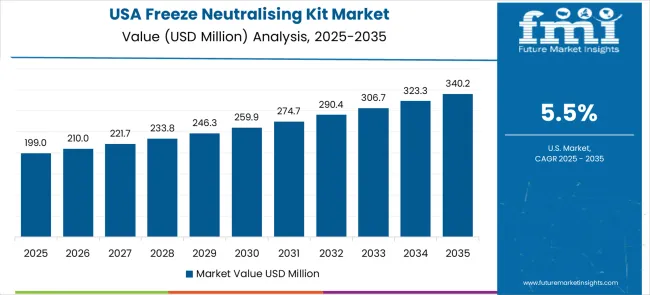
The USA market leads in advanced neutralising system innovation based on integration with artificial intelligence and precision guidance platforms for tactical analytics. The country shows strong potential with a CAGR of 5.5% through 2035, driven by operational effectiveness optimisation under security and reliability constraints across military, law enforcement, and security sectors. American defence facilities are adopting freeze neutralising systems for tactical efficiency improvement and operational compliance, particularly in regions with advanced security requirements. Technology deployment channels through defence contractors and direct manufacturer relationships expand coverage across military installations and security facilities. Implementation of advanced neutralising platforms demonstrates the successful integration of freeze neutralising systems with existing defence infrastructure.
Leading market segments:
Japan's Freeze Neutralising Kit market demonstrates sophisticated implementation focused on precision security and operational control optimisation, with documented integration of neutralising systems achieving 20% improvement in tactical effectiveness across defence and law enforcement facilities. The country maintains steady growth momentum with a CAGR of 4.4% through 2035, driven by security facilities' emphasis on operational excellence and continuous improvement methodologies that align with advanced security principles. Major security centres, including Tokyo, Osaka, and Kyoto, showcase advanced deployment of tactical platforms where neutralising systems integrate seamlessly with existing security management systems and automated tactical controls.
Key market characteristics:
In London, Manchester, and Edinburgh, security facilities are implementing freeze neutralising kits to meet operational effectiveness targets under the UK's defence modernisation strategy, with military units achieving 18% tactical improvement through optimised neutralising control. The market shows moderate growth potential with a CAGR of 4.9% through 2035, linked to operational requirements and defence enhancement initiatives that mandate tactical efficiency improvements. British security forces are adopting precision neutralising and tactical platforms to reduce operational risks while maintaining competitiveness in global security operations, where tactical performance increasingly influences mission success. The country's established defence sector creates sustained demand for specialised neutralising solutions that support both operational efficiency and security compliance across diverse tactical applications.
Market development factors:
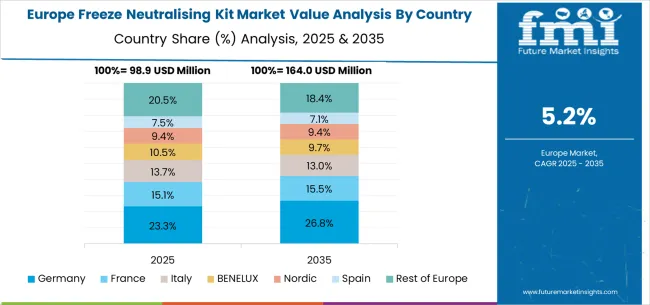
The freeze neutralising kit market in Europe is projected to grow from USD 89.2 million in 2025 to USD 156.8 million by 2035, registering a CAGR of 5.8% over the forecast period. Germany is expected to maintain its leadership position with a 28.4% market share in 2025, declining slightly to 27.9% by 2035, supported by its advanced defence infrastructure and major military installations, including specialised forces bases and security training centres.
France follows with a 19.6% share in 2025, projected to reach 20.1% by 2035, driven by comprehensive military modernisation programs and enhanced security protocols across major defence installations. The United Kingdom holds a 17.8% share in 2025, expected to decrease to 17.2% by 2035 due to post-Brexit defence operational adjustments. Italy commands a 14.5% share, while Spain accounts for 11.3% in 2025. The Rest of Europe region is anticipated to gain momentum, expanding its collective share from 8.4% to 9.6% by 2035, attributed to increasing adoption of neutralising kits in Nordic countries and emerging Eastern European security forces implementing modernisation programs.
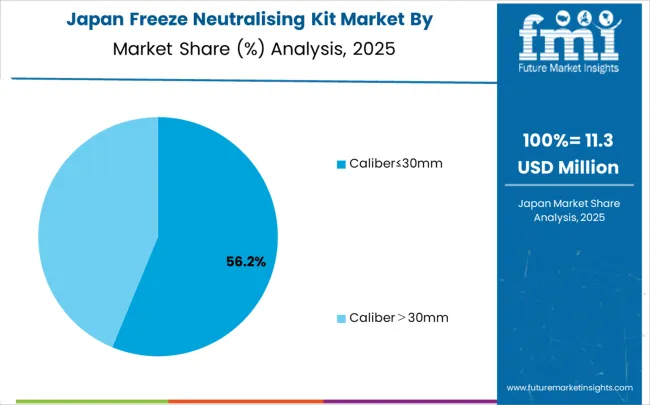
The Japanese freeze neutralising kit market demonstrates a mature and precision-focused landscape, characterised by sophisticated integration of calibre ≤30mm systems with existing tactical infrastructure across military, law enforcement, and security facilities. Japan's emphasis on operational excellence and tactical precision drives demand for high-accuracy neutralising solutions that support continuous improvement initiatives and tactical control requirements. The market benefits from strong partnerships between international technology providers like Chemring Technology, Steberg, and domestic security leaders, creating comprehensive service ecosystems that prioritise system reliability and operator training. Security centres in Tokyo, Osaka, and Kyoto showcase advanced tactical implementations where neutralising systems achieve 95% operational readiness through integrated training programs, while the country's focus on tactical efficiency, compliance and operational safety monitoring supports steady adoption of precision neutralising technologies across diverse security sectors.
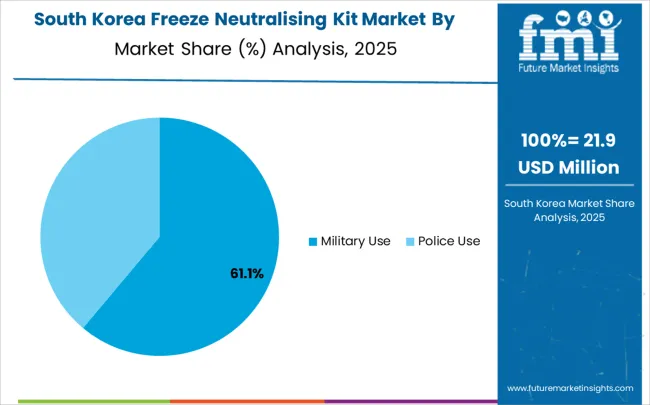
The South Korean freeze neutralising kit market is characterised by strong international technology provider presence, with companies like Chemring Technology, Steberg, and Richmond Defence Systems maintaining dominant positions through comprehensive system integration and maintenance services capabilities. The market is demonstrating a growing emphasis on localised technical support and rapid response capabilities, as Korean security operators increasingly demand customised solutions that integrate with domestic tactical infrastructure and operational processes. Local defence companies and regional distributors are gaining market share through strategic partnerships with global providers, offering specialised services, including training programs and certification services for tactical personnel. The competitive landscape shows increasing collaboration between multinational neutralising system manufacturers and Korean defence specialists, creating hybrid service models that combine international technology expertise with local market knowledge and customer relationship management, particularly in the country's concentrated security regions around Seoul, Busan, and Daegu, where defence industries drive continuous demand for advanced neutralising solutions.
The freeze neutralising kit market features approximately 10-15 meaningful players with moderate concentration, where the top three companies control roughly 40-45% of global market share through established technology platforms and extensive defence customer relationships. Competition centres on technological differentiation, service capabilities, and tactical integration expertise rather than price competition alone.
Market leaders include Chemring Technology, Steberg, and Richmond Defence Systems, which maintain competitive advantages through comprehensive security portfolios, global service networks, and deep tactical process expertise, creating high switching costs for customers. These companies leverage installed base relationships and ongoing service contracts to defend market positions while expanding into adjacent neutralising applications.
Challengers encompass PT Merpati Wahana Raya and other regional specialists, which compete through specialised neutralising solutions and strong regional presence in key defence markets. Technology specialists focus on specific neutralising technologies or vertical applications, offering differentiated capabilities in precision delivery, tactical control integration, and operational analytics platforms.
Regional players and emerging technology providers create competitive pressure through cost-effective solutions and rapid deployment capabilities, particularly in high-growth markets including China and India, where local presence provides advantages in customer support and regulatory compliance. Market dynamics favour companies that combine advanced neutralising technologies with tactical integration and comprehensive service offerings that address the complete system lifecycle from installation through ongoing optimisation.
The global freeze neutralising kit market represents a specialised segment within defence and security technologies, projected to grow from USD 411.3 million in 2025 to USD 722.7 million by 2035. These non-lethal neutralisation systems, particularly calibre ≤30mm variants, serve critical roles in military operations and law enforcement, offering precision threat management without permanent harm. The market's expansion is driven by increasing demand for advanced security solutions, operational safety requirements, and the need for versatile tactical capabilities across diverse threat scenarios. Achieving sustained growth requires coordinated action across government agencies, industry standards bodies, technology providers, defence contractors, and investment communities.
How Governments Could Accelerate Market Development and Adoption?
Defence Procurement & Specification: Establish clear technical specifications and procurement pathways for freeze neutralising kits across military branches and law enforcement agencies, including standardised calibre requirements, performance benchmarks, and interoperability standards with existing tactical systems.
R&D Investment & Innovation: Fund research into advanced delivery mechanisms, precision targeting systems, and enhanced safety protocols through defence innovation programs. Support the development of next-generation neutralising technologies that improve operational effectiveness while reducing collateral impact risks.
Regulatory Framework Development: Create comprehensive approval processes for military-grade and police-use applications, including safety certifications, operational guidelines, and training requirements. Establish export control frameworks that balance security interests with legitimate commercial opportunities.
Training & Capacity Building: Invest in specialised training facilities and certification programs for military and law enforcement personnel, ensuring proper deployment techniques, tactical integration, and safety protocols are maintained across all operational scenarios.
Strategic Partnerships: Foster international cooperation on standardising kits and operational protocols, particularly with allied nations, to create interoperable systems and shared best practices for diverse security environments.
How Industry Bodies Could Support Market Standardisation and Growth?
Technical Standards Development: Establish industry-wide standards for neutralising effectiveness, delivery accuracy, safety parameters, and system reliability across different calibre sizes and operational environments, enabling reliable performance comparisons between suppliers.
Operational Guidelines & Best Practices: Develop comprehensive deployment protocols for military and police applications, including tactical integration procedures, mission-specific usage guidelines, and post-deployment assessment frameworks.
Testing & Certification Programs: Create standardised testing methodologies for neutralising kit performance, including accuracy measurements, environmental durability assessments, and safety validation protocols that support procurement decisions.
Market Intelligence & Analysis: Provide regular market assessments covering technology trends, competitive dynamics, regional adoption patterns, and emerging applications to guide strategic planning for manufacturers and end-users.
Professional Development: Organise technical conferences, training workshops, and knowledge-sharing platforms that advance industry expertise in neutralising technologies and tactical applications.
How Technology Providers and Defence Contractors Could Strengthen the Ecosystem?
Advanced Delivery Systems: Develop precision-guided neutralising platforms with enhanced accuracy, reduced collateral impact, and improved operational flexibility for both close-range and extended-range applications across diverse tactical scenarios.
Integrated Tactical Solutions: Create comprehensive neutralising systems that integrate seamlessly with existing military communication networks, targeting systems, and command-and-control infrastructure to improve overall operational effectiveness.
Modular System Architecture: Design scalable, modular neutralising platforms that can be customised for specific mission requirements, enabling cost-effective deployment across different military branches and law enforcement agencies.
AI-Enhanced Targeting: Incorporate artificial intelligence and precision guidance technologies that improve target identification, reduce operator training requirements, and enhance safety protocols through automated threat assessment capabilities.
Maintenance & Support Infrastructure: Establish comprehensive service networks providing technical support, system maintenance, software updates, and performance optimisation to ensure sustained operational readiness across global deployments.
How Defence Procurement Agencies Could Navigate Market Evolution?
Strategic Sourcing Models: Develop long-term procurement strategies that balance cost efficiency with technological advancement, including framework agreements with multiple suppliers and performance-based contracting models.
Technology Roadmap Alignment: Align neutralising kit procurement with broader defence modernisation programs, ensuring compatibility with future tactical systems and operational requirements across different threat environments.
Risk Assessment & Management: Implement comprehensive evaluation protocols for neutralising technologies, including operational testing, safety validation, and cost-effectiveness analysis to support informed procurement decisions.
Supplier Development: Work with technology providers to enhance manufacturing capabilities, quality assurance processes, and technical support infrastructure needed to meet growing demand across global markets.
International Coordination: Collaborate with allied defence agencies on joint procurement initiatives, technology sharing agreements, and standardisation efforts that improve interoperability and reduce overall system costs.
How Investors and Financial Partners Could Unlock Market Potential?
Technology Innovation Funding: Provide venture capital and growth funding for startups developing next-generation neutralising technologies, precision guidance systems, and advanced safety mechanisms that address evolving tactical requirements.
Manufacturing Scale-Up Capital: Finance production facility expansion, automated manufacturing systems, and quality control infrastructure needed to meet growing global demand while maintaining stringent defence industry standards.
Market Expansion Support: Fund international market development initiatives, including regulatory compliance, local partnership establishment, and technical support infrastructure in high-growth regions like Asia-Pacific.
Strategic Consolidation: Support industry consolidation through M&A financing that creates larger, more capable organisations able to serve global defence customers and invest in advanced R&D programs.
Defence Industry Integration: Provide capital for vertical integration initiatives that combine neutralising kit manufacturers with delivery system providers, creating comprehensive tactical solution capabilities for military and law enforcement customers.
| Item | Value |
|---|---|
| Quantitative Units | USD 411.3 million |
| Caliber Size | Caliber≤30mm, Caliber>30mm |
| Application | Military Use, Police Use |
| Regions Covered | North America, Latin America, Europe, East Asia, South Asia & Pacific, Middle East & Africa |
| Country Covered | China, India, Germany, Brazil, the USA, the UK, Japan, and 40+ countries |
| Key Companies Profiled | Chemring Technology, Steberg, Richmond Defence Systems, PT Merpati Wahana Raya |
| Additional Attributes | Dollar sales by calibre size and application categories, regional adoption trends across North America, Europe, and Asia-Pacific, competitive landscape with technology providers and system integrators, security facility preferences and requirements, integration with advanced tactical initiatives and precision platforms, innovations in neutralising technology and tactical analytics, and development of specialised neutralising applications with operational compliance capabilities. |
The global freeze neutralising kit market is estimated to be valued at USD 411.3 million in 2025.
The market size for the freeze neutralising kit market is projected to reach USD 722.7 million by 2035.
The freeze neutralising kit market is expected to grow at a 5.8% CAGR between 2025 and 2035.
The key product types in freeze neutralising kit market are caliber≤30mm and caliber>30mm.
In terms of application, military use segment to command 60.0% share in the freeze neutralising kit market in 2025.






Our Research Products

The "Full Research Suite" delivers actionable market intel, deep dives on markets or technologies, so clients act faster, cut risk, and unlock growth.

The Leaderboard benchmarks and ranks top vendors, classifying them as Established Leaders, Leading Challengers, or Disruptors & Challengers.

Locates where complements amplify value and substitutes erode it, forecasting net impact by horizon

We deliver granular, decision-grade intel: market sizing, 5-year forecasts, pricing, adoption, usage, revenue, and operational KPIs—plus competitor tracking, regulation, and value chains—across 60 countries broadly.

Spot the shifts before they hit your P&L. We track inflection points, adoption curves, pricing moves, and ecosystem plays to show where demand is heading, why it is changing, and what to do next across high-growth markets and disruptive tech

Real-time reads of user behavior. We track shifting priorities, perceptions of today’s and next-gen services, and provider experience, then pace how fast tech moves from trial to adoption, blending buyer, consumer, and channel inputs with social signals (#WhySwitch, #UX).

Partner with our analyst team to build a custom report designed around your business priorities. From analysing market trends to assessing competitors or crafting bespoke datasets, we tailor insights to your needs.
Supplier Intelligence
Discovery & Profiling
Capacity & Footprint
Performance & Risk
Compliance & Governance
Commercial Readiness
Who Supplies Whom
Scorecards & Shortlists
Playbooks & Docs
Category Intelligence
Definition & Scope
Demand & Use Cases
Cost Drivers
Market Structure
Supply Chain Map
Trade & Policy
Operating Norms
Deliverables
Buyer Intelligence
Account Basics
Spend & Scope
Procurement Model
Vendor Requirements
Terms & Policies
Entry Strategy
Pain Points & Triggers
Outputs
Pricing Analysis
Benchmarks
Trends
Should-Cost
Indexation
Landed Cost
Commercial Terms
Deliverables
Brand Analysis
Positioning & Value Prop
Share & Presence
Customer Evidence
Go-to-Market
Digital & Reputation
Compliance & Trust
KPIs & Gaps
Outputs
Full Research Suite comprises of:
Market outlook & trends analysis
Interviews & case studies
Strategic recommendations
Vendor profiles & capabilities analysis
5-year forecasts
8 regions and 60+ country-level data splits
Market segment data splits
12 months of continuous data updates
DELIVERED AS:
PDF EXCEL ONLINE
Freezer Label Market Size and Share Forecast Outlook 2025 to 2035
Freezer Liner Market Size and Share Forecast Outlook 2025 to 2035
Freeze Drying Market - Size, Share, and Forecast Outlook 2025 to 2035
Freeze Dried Fruit Powder Market Size and Share Forecast Outlook 2025 to 2035
Freeze-dried Food Market Analysis - Size, Growth, and Forecast 2025 to 2035
Freeze Dried Fruits Market Analysis - Size, Share, and Forecast Outlook 2025 to 2035
Freeze Drying Equipment Market Size and Share Forecast Outlook 2025 to 2035
Freezer Paper Market Size and Share Forecast Outlook 2025 to 2035
Freeze Dried Fruits And Vegetables Market Size and Share Forecast Outlook 2025 to 2035
Freeze-Dried Vegetables Market Analysis - Size, Share, and Forecast Outlook 2025 to 2035
Freeze-Dried Pet Food Market Anlysis by Pet Type, Nature, Source, Process Type, and Sales Channel Through 2035
Freeze Dried Melt Market Analysis by Product Form, Fruit Type, Sales Channel, Packaging, , and Region Through 2035
Freezer Bags Market Growth, Trends and Demand from 2025 to 2035
Competitive Overview of Freeze Dried Fruits Market Share
Competitive Breakdown of Freezer Paper Manufacturers
Freezer Tape Market
UK Freeze Dried Fruits Market Insights – Size, Demand & Industry Growth 2025–2035
Antifreeze proteins Market Size and Share Forecast Outlook 2025 to 2035
Antifreeze Market Size and Share Forecast Outlook 2025 to 2035
USA Freeze Dried Fruits Market Growth – Innovations, Trends & Forecast 2025–2035

Thank you!
You will receive an email from our Business Development Manager. Please be sure to check your SPAM/JUNK folder too.
Chat With
MaRIA